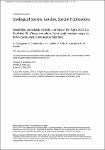Modelling pyroclastic density currents of the April 2021 La Soufrière St. Vincent eruption: from rapid invasion maps to field-constrained numerical simulations
| dc.contributor.author | Gueugneau, V | |
| dc.contributor.author | Charbonnier, S | |
| dc.contributor.author | Miller, VL | |
| dc.contributor.author | Cole, Paul | |
| dc.contributor.author | Grandin, R | |
| dc.contributor.author | Dualeh, EW | |
| dc.date.accessioned | 2023-06-05T10:08:52Z | |
| dc.date.available | 2023-06-05T10:08:52Z | |
| dc.date.issued | 2024-04-01 | |
| dc.identifier.issn | 0305-8719 | |
| dc.identifier.issn | 2041-4927 | |
| dc.identifier.uri | https://pearl.plymouth.ac.uk/handle/10026.1/20951 | |
| dc.description.abstract |
<jats:title>Abstract</jats:title> <jats:p> The April 2021 La Soufrière of St. Vincent eruption generated several pyroclastic density currents (PDCs) during the two weeks of the crisis, from April 9 <jats:sup>th</jats:sup> to April 22 <jats:sup>nd</jats:sup> . To support the hazard assessment team during this eruption, numerical simulations were performed in real time and generated rapid scenario-based PDC invasion maps with the two-phase version of the code VolcFlow, which was able to simulate both the concentrated and dilute regime of PDCs. To generate the maps, only the source properties (shape and location) and the initial volume used to generate the PDCs were varied, all other input parameters were kept constant and estimated from previous simulations. New simulations were then performed based on the field-based deposit map to assess the code's ability to simulate such PDCs. Results show that the syn-crisis invasion maps satisfactorily mimic the observed valley-confined PDCs, while unconfined dilute PDCs were overestimated. The result also highlight that simulation results are greatly improved with additional field-based data, which help constrain the PDC sequence. Numerous lessons were learned, including: (i) how to choose the most critical input parameters, (ii) the importance of syn-eruptive radar imagery, and (iii) the potential of this two-phase model for rapid hazard assessment purposes. </jats:p> | |
| dc.format.extent | sp539-2022-290- | |
| dc.language | en | |
| dc.publisher | Geological Society of London | |
| dc.title | Modelling pyroclastic density currents of the April 2021 La Soufrière St. Vincent eruption: from rapid invasion maps to field-constrained numerical simulations | |
| dc.type | journal-article | |
| plymouth.issue | 1 | |
| plymouth.volume | 539 | |
| plymouth.publication-status | Published online | |
| plymouth.journal | Geological Society, London, Special Publications | |
| dc.identifier.doi | 10.1144/sp539-2022-290 | |
| plymouth.organisational-group | |Plymouth | |
| plymouth.organisational-group | |Plymouth|Faculty of Science and Engineering | |
| plymouth.organisational-group | |Plymouth|Faculty of Science and Engineering|School of Geography, Earth and Environmental Sciences | |
| plymouth.organisational-group | |Plymouth|REF 2021 Researchers by UoA | |
| plymouth.organisational-group | |Plymouth|Users by role | |
| plymouth.organisational-group | |Plymouth|Users by role|Academics | |
| plymouth.organisational-group | |Plymouth|REF 2021 Researchers by UoA|UoA07 Earth Systems and Environmental Sciences | |
| dcterms.dateAccepted | 2023-05-12 | |
| dc.date.updated | 2023-06-05T10:08:47Z | |
| dc.rights.embargodate | 2023-6-7 | |
| dc.identifier.eissn | 2041-4927 | |
| dc.rights.embargoperiod | forever | |
| rioxxterms.versionofrecord | 10.1144/sp539-2022-290 |


